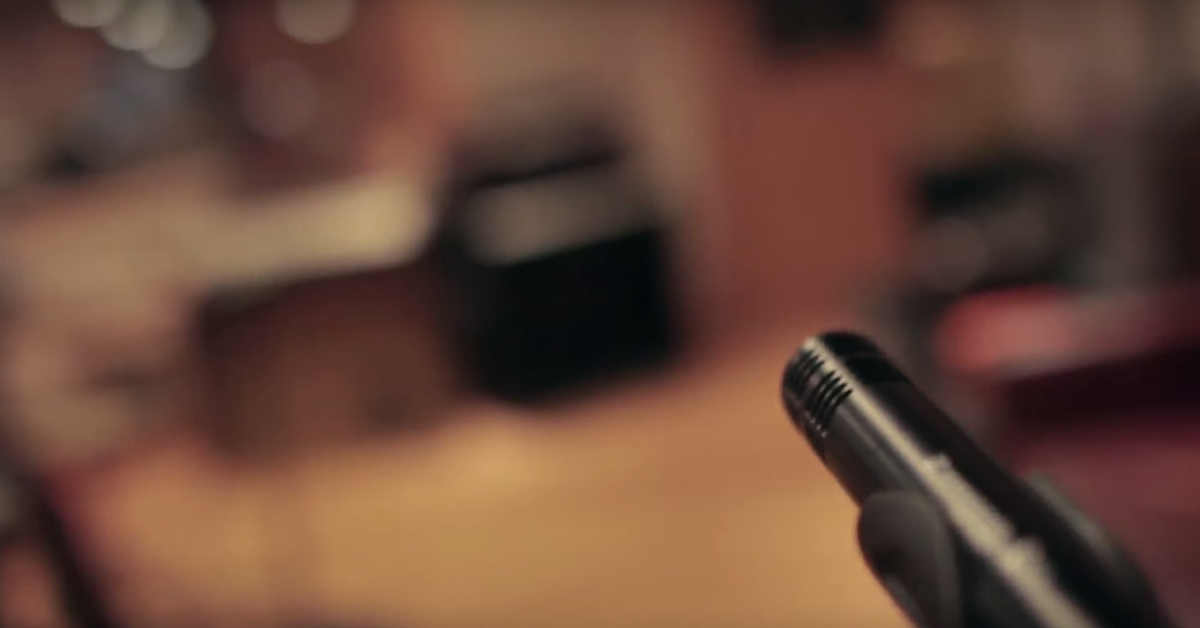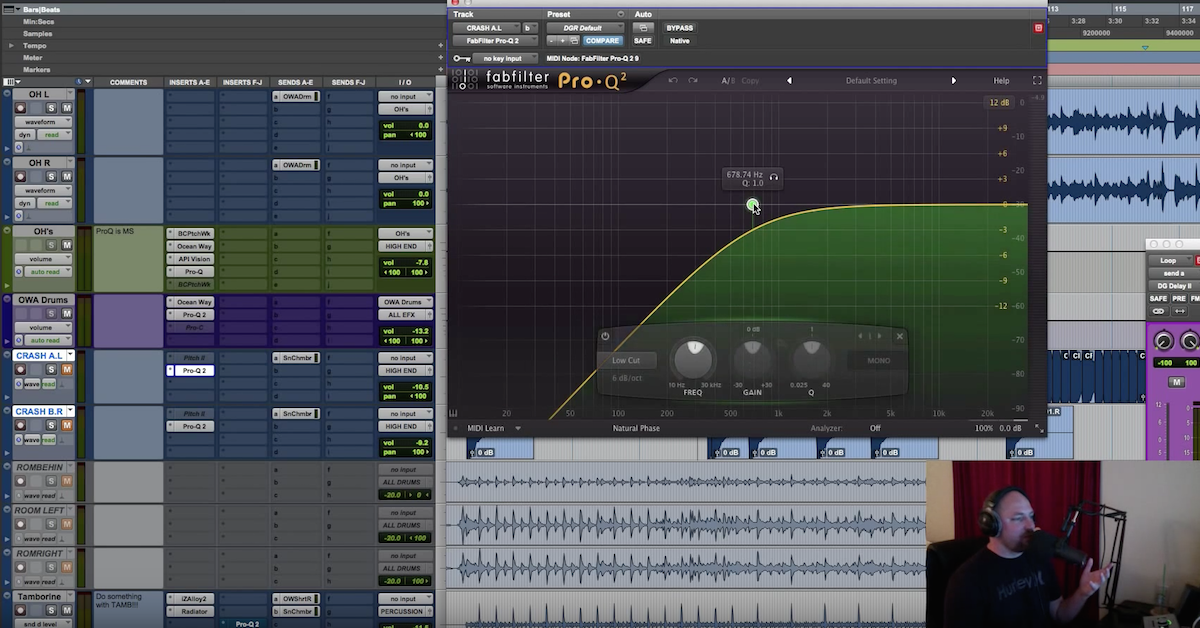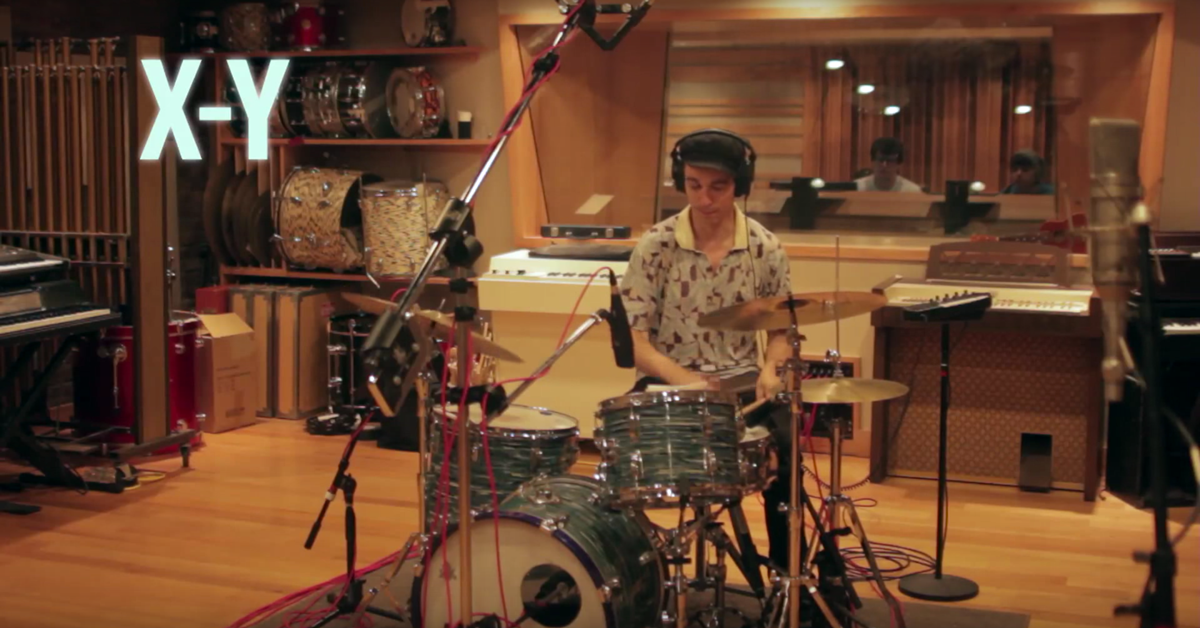How to Repair Overhead Mics in a Mix
Today we’ve got a pair of overhead mics we’re going to talk about. They have come to me high passed, low cut, no lows at all. Super compressed and we’re going to look at the before and then we’re going to look at the after soloed and then in context with the drum kit, and then we’re going to talk about why you might want either of those options in your productions or mixes.
So first things first, let me show you the before. This is a song called No Greater Love. I’ve just soloed the drums, but I’m going to give a shoutout to my man Arthur G. We’re featuring this song July 2016 in The Mix Academy. So you can go to themixacademy.com if you want to get your hands on these files and mix them for yourself.
These are the overheads before.
[overheads]
Okay. So you can hear, super compressed, no lows at all, upper mid-range and top end. Maybe we’d call that using the overheads as cymbal mics. So that’s the first example.
Then what I did to them is really the most important thing. There’s VMR here for VCC, but I’ll quickly show you before and after, this is just adding maybe a little bit of thickness, a little bit of grit, not much.
[overheads with VCC]
Maybe a little upper mid-range and a little bit of volume as well. I tried to keep that level, but anyways, that’s not the point of this. This video, I want to feature what I’ve done here.
So these came in high passed, and now I’m going to add some love back in.
Now, if something has been high passed, it doesn’t mean that it’s a done deal. That it’s gone forever. You just have to boost with your ears. So that’s a point of this video is just using your ears to boost. I’ve got 20dB. If I zoom in here on this EQ at around 583.58Hz. [laughs] 600Hz or so. Here’s the difference, one more time before.
[overheads, before EQ]
And after.
[overheads, after EQ]
Okay. Still not the most amazing overhead drum sound you could possibly get. I got to reveal a little bit to you here, I actually produced this song — co-produced it with my buddy Victor Encarnacion and the artist Arthur G and then I programmed these drums using Superior’s — Toon Track Superior Drummer 2.0. I can’t remember which kit. It might’ve been the New York kit.
But I’m the one that high passed these originally. I produced it four, five, six years ago, I can’t remember when I actually started tracking it, but I went with the high passed sound. Let’s talk about what I did here real quick, and then I want to point out the benefits of either of those, and when you might want to try using them.
So first thing, the biggest move on this EQ here is the 600Hz boost at 20dB or so, and that is the main guy right there giving life to the kit and bringing back the toms. Without it…
[overheads, no EQ]
And with it.
[overheads, with EQ]
So now you can feel the toms are more active in this mic again.
The high-pass, low cut right here at 105Hz is just protection to make sure none of the super low end rumble — I’ve got kick — actually two kick mics, one featuring the sub frequencies, one featuring the punch. We’ve got the bass, we have other sub elements. I’ve got sub harmonics that I’m adding to pads and automating and managing my low end.
So I want to be careful to not let the overhead mics — oh, and we still have the tom mics, the direct mics.
So I want to be careful how much lows I let these overhead mics have, but I wanted to keep that under control with a high pass.
So those two are the main points of the EQ, but then because I have direct mics, I’m going to go ahead and play those for you. So come over here and we’ll hear everything in context.
Because I have direct mics on these toms and the mallet-ed kick drum I created…
[direct mics]
Okay. Because I have direct mics featuring the clarity and the power and the oomph of the toms, I wanted to make sure that the overhead mics complimented that sound and it didn’t get too boxy. So it’s a trade off. How much of the mid-range do I want for the cymbals, and then how much do I want to control the tom sound in the overhead mics?
So let me show you these two points right here. 464Hz down 4.5dB, 759Hz down almost 6dB. Without them in the picture, the toms in the overheads sound like this.
[overheads]
Then I’m going to put them back in, reducing these frequencies.
[overheads, EQ adjustments]
So now in the overhead mics, those toms more-so resemble the direct mic toms, whereas before, it’s a little bit boxy, a little bit of that — which could be cool, depending upon the song, the genre, etcetera, but I wanted the overheads to sound similar and be shaped comparable to the direct mics.
So a little bit of that, I added a little bit of top end boost, just kind of corrective EQ. I felt like they were a little harsh. Shame on me. This is production that I did four or five years ago.
Here is the difference between them in context. What you really want to listen for here is the cymbals and how it affects the toms. Here is before any EQ. Again, this is the high passed overhead sound.
[high passed overheads in context]
Hear those cymbals, right?
Okay, so now with the processing putting that EQ back in, the drums should sound a little fuller, but you be the judge.
[overheads with EQ]
Okay. Now one more time, I’m going to have them as is the way you just heard them, and then I’m going to mute the overheads and you’ll hear the difference of the cymbals.
[drums, with and without overheads]
Okay, so we still have some shiny cymbals, but now we have a little bit more of a roomier tone, it’s not just direct mics. I feel like it blends better and helps the drums sound like one instrument as opposed to a bunch of individual mics.
So I kind of touched on why you might want to high pass or add lows back into a high passed set of overheads. A little bit as I explained what was going on, but let’s break it down and just kind of recap.
So these came in high passed and I wanted something more full. So to do that, use your ears, not your eyes, boost as much as you need with an EQ, a shelf, a bell, whatever to get the sound that you’re after.
The second point was if you have drums that come to you and they’re not high passed and you want to high pass them, you may want to do that just to feature the cymbals in that set of overhead mics, and that’s okay, you can do that. Tons of different mixers who do it different ways.
That — in that situation, I might do that if I want to remove the kick drum or the toms or the meat of the snare. Maybe I’m going to replace or blend extra samples in and they don’t work with what was in the overheads to begin with. I’m kind of always going back and checking samples against overheads, how does that feel, how does that fit.
The end goal of all of this is for me, in this video, to help the drums feel a little bit more like one instrument and not a bunch of different mics on the kit. That’s great, that helps us control the sound, but now I want to kind of blend them and use the overheads and the room mic that was given to help it feel like one instrument and feel like it’s one kit.
So I’ve rambled, talked a little bit about that. If you have any questions about any of this, maybe I left you hanging on some information on this, please, hit me with a comment below if you liked the video, like, subscribe, please tell your friends, share this one, it helps us a ton to help keep bringing you awesome free content.
Themixacademy.com for more of the premium tutorials from David Glenn Recording and The Pro Audio Files. We will see you in many more to come. Thanks for watching.






